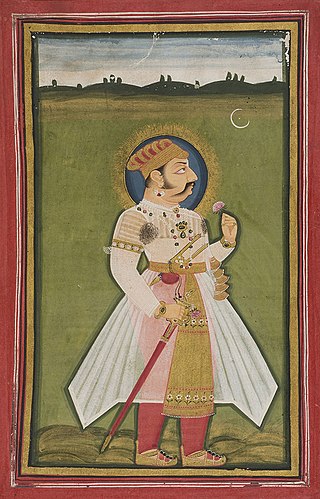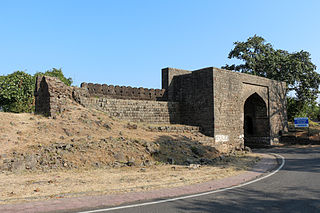
Rana Sangram Singh I, popularly known as Rana Sanga was the Maharana of Mewar from 1508 to 1528 CE. Belonging to the Sisodia Rajput dynasty, through his capable leadership, he transformed the Kingdom of Mewar into the most powerful state in northern India in the early 16th century. He controlled parts of present-day Rajasthan, Gujarat and Madhya Pradesh with his capital at Chittor. His reign was admired by several of his contemporaries, including the first Mughal Emperor Babur, who described him as the "greatest Indian ruler" of that time. The Mughal historian Abd al-Qadir Badayuni called Sanga the bravest of all Rajputs. Rana Sanga was the last independent ruler of northern India to control a significant territory before Mughal invasion.
Maharana Hammir Singh (1302–1364), or Hammir, was a 14th-century ruler of Mewar in present-day Rajasthan, India. Hammir Singh, was a scion of the cadet branch Rana of the Guhila dynasty, who regained control of the region, re-established the dynasty after defeating the Tughlaq dynasty, and captured present-day Rajasthan from Muslim forces of Delhi and became the first of the 'Rana' branch to become the King of Mewar with title of Maharana. Hammir also became the progenitor of the Sisodia clan, a branch of the Guhila dynasty, to which every succeeding Maharana of Mewar has belonged.

Rao Jodha was the 15th Rajput chief of Rathore clan who ruled the Kingdom of Marwar in the present-day state of Rajasthan. He was the fifth son of Rao Ranmal. He is known for his illustrious military career and for founding the city of Jodhpur in 1459, which subsequently became the new capital of Marwar after Mandore.

Rana Kumbha or Kumbhkaran Singh (1433–1468), popularly known as Maharana Kumbha, was the ruler of the Kingdom of Mewar. He belonged to the Sisodia clan of Rajputs. It was during his reign that Mewar became one of the most powerful political powers in northern India. He is said to be the most potentially stabled sovereign of his time and his dynasty in general.

The Chittorgarh, also known as Chittod Fort, is one of the largest living forts in India. It is a UNESCO World Heritage Site. The fort was the capital of Mewar and is located in the present-day city of Chittorgarh. It sprawls over a hill 180 m (590.6 ft) in height spread over an area of 280 ha above the plains of the valley drained by the Berach River. The fort covers 65 historic structures, which include four palaces, 19 large temples, 20 large water bodies, 4 memorials and a few victory towers.

The Kingdom of Mewar, sometimes known as Udaipur State, was an independent kingdom in Rajputana region of India, ruled by the Sisodia dynasty. It was established around the 6th century by the minor rulers of the Nagada-Ahar region of Udaipur and later, in the 10th century, it transformed into an independent state under Rawal Bharttripatta II.
Raimal Singh Sisodia, also known as Rana Raimal, was a Hindu Rajput ruler of Mewar. Maharana Raimal was the son of Rana Kumbha and his Rathore queen, a princess of Idar.
Hindu Rajput kingdoms in the north-western Indian subcontinent resisted the Muslim invasions of India, beginning with the Umayyad campaigns from the Middle East and the Ghaznavid Turks from Central Asia. They continued resistance against subsequent Muslim empires, including the Arabs, Ghaznavids, Ghurids, Delhi Sultans and the Mughals.
Rana Kshetra Singh (1364-1382), was the Sisodia Rajput ruler of Mewar Kingdom. He was the eldest son of his father and predecessor Rana Hammir Singh the progenitor of Sisodias.In his reign, he conquered the territories of Ajmer and Mandalgarh.

Mahmud Khalji (1436–1469), also known as Mahmud Khilji and Ala-ud-Din Mahmud Shah I, was the Sultan of Malwa, in what is now the state of Madhya Pradesh, India. Khilji came into power after assassinating Mohammad, the son of the previous ruler, Hoshang Shah, in 1435. He mounted an unsuccessful campaign against the Delhi Sultanate however, it was under his reign that the Malwa Sultanate reached its greatest height.
The Battle of Dholpur was fought between the Kingdom of Mewar under Rana Sanga and the Lodi dynasty of the Delhi Sultanate under Ibrahim Lodi resulting in a Mewar victory.

The Battle of Gagron was fought in 1519 between Mahmud Khalji II of Malwa and Rajput Confederacy of Rana Sanga. The conflict took place in Gagron and resulted in Sanga's victory, with him taking Mahmud captive and annexing significant territory.
In 1520 A.D. Rana Sanga led a coalition of Rajput armies to invade Gujarat. He reinstated Raimal Rathore as the Rao of Idar and defeated the Gujarat forces under the command of Nizam Khan. Rana Sanga drove the army of Muzaffar II deep into Gujarat and chased them up to Ahmedabad. The Sultan of Gujarat was forced to flee to Muhammadabad. Maharana Sanga laid siege to the Ahemdnagar and conquered it. After a series of successful military campaigns Sanga successfully captured Northern Gujarat.

The Battle of Sarangpur was fought between Rana Kumbha and Sultan Mahmud Khilji. Mahpa Panwar, who was one of the assassins of Rana Mokal, was sheltered by the Sultan of Mandu. A demand for this person was made by Rana Kumbha, but Mahmud Khilji refused to surrender the refugee. The Rana prepared for hostilities and advanced to attack Mandu. The Sultan advanced with a powerful army to meet Kumbha.

Muzaffar Shah I, born Zafar Khan, was the founder of the Muzaffarid dynasty in Medieval India, reigning over the Gujarat Sultanate from 1391 to 1403 and again from 1404 to 1411. The Kumbalgarh inscription says that Kshetra Singh defeated and captured Zafar Khan, King of Patan and the Khan remain in imprisonment with other Rajas.
Qutb-ud-Din Ahmad Shah II, born Jalal Khan, was a ruler of the Muzaffarid dynasty, who reigned over the Gujarat Sultanate from 1451 to 1458. He defeated invading Malwa forces at the battle of Kapadvanj. He tried to capture Nagor and came in conflict with Rana Kumbha of Chittor.

The Mewar- Malwa conflict was a series of wars between the Kingdom of Mewar and the Islamic Sultanate of Malwa. The conflict erupted due to mutual territorial expansion triggered by both sides on each other. The war was fought in what is now known as the Indian states of Rajasthan and Madhya Pradesh. The Rana branch of the Guhilas, following their successful recovery of the Rajput stronghold of Chittorgarh and the entire region of Mewar alongside Rajputana after the Battle of Singoli, embarked on an ambitious expansion at the cost of their neighboring kingdoms. On the other side, with the invasion of Timur, the Lame Delhi Sultanate grew weak with its multiple subahs gaining independence which included Malwa, adjacent to Mewar.
The Conquest of Ajmer was a military expedition launched by the Sultan Mahmud Khalji of Malwa aimed to conquer and subdue the region of Mewar, which was under the control of the Mewar kingdom.This military expedition was undertaken against Mewar with the intention of seeking revenge from Rana Kumbha of Mewar. It was a major military conquest carried out during the reign of Mahmud Khalji with the goal of expanding territorial control.Although Mahmud was victories in this campaign, he was not able to hold Ajmer for a longer period of time.As it was later reconquered by Rana Kumbha

The Conquest of Mandalgarh was a military expedition led by Sultan Mahmud Khalji of Malwa against Mewar. The primary objective of this campaign was to capture the Mandalgarh fort, which was under the command of Uparamal, a subordinate of Rana Kumbha. Mahmud Khalji marched towards Mewar in the year 1457 to achieve this goal.










